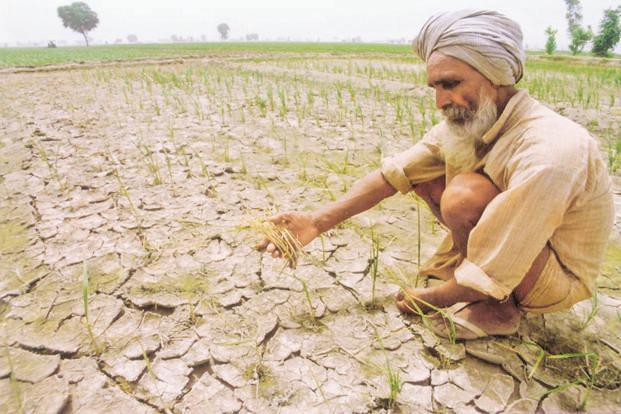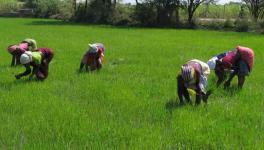Battling Corporate Concentration in Agriculture

Farmers’ leaders, civil society activists, academics and researchers came together recently for a symposium in the south Indian city of Bangalore. Titled ‘Corporate Concentration in Agriculture and Food’, the two-day colloquium was organized by Focus on Global South, Alternative Law Forum and Rosa Luxemburg Stiftung.
Panel discussions at the symposium covered the changing nature of the state following the neoliberal reforms in the 1990s; the increasing corporate control over different components of agriculture such as seeds, fertilizers and technology through Intellectual Property Rights; land grabs to profit from real estate speculation; and the use of different trade agreements to capture and rig markets in the global south.
The final session which followed these discussions was dedicated to charting the way forward for peasant movements and civil society to resist corporate capture and to reverse the worsening of the plight of the peasantry.
In this session, panelists and participants agreed on the need to begin preparations to mobilize to demand for a special legislative sessions to discuss the agrarian crisis in States not ruled by the Bharatiya Janata Party (BJP).
Last year, one of the key demands made by the peasant organizations which undertook a number of mass agitations was a three-week long special session in the parliament, exclusively dedicated to discussing the agrarian crisis.
Over the last two decades, more than 300,000 farmers have committed suicide, mostly due to indebtedness. In the same period, an average of 2,000 peasants have been quitting full-time agriculture daily. Industry, on the other hand, has not been growing at a rate that can absorb any significant portion of these people. This has pushed millions into a precarious existence.
However, despite the mass agitations, the far-right BJP-led government had not paid heed to this demand. Instead, it managed to ride back to power in the election this year, banking on the religious polarization and a cultural jingoism it carefully cultivated in Indian society since coming to power in 2014.
Nevertheless, 12 of the 29 States in the country are still ruled by non-BJP governments. During the time of the peasant agitations, 21 political parties, including those ruling these 12 States, had expressed their support for a special legislative session. Participants of the symposium agreed that the push for the special parliamentary session has to begin by pressurizing these non-BJP state governments to hold a special session at their State legislatures.
The nature of the challenges facing the agrarian economy has been changing at an increasing pace since the neoliberal reforms. Post-independence, the biggest agrarian challenge was the fact that a small landholding class owned a majority of the land and capital required for cultivation.
With the half-hearted land-reforms undertaken by different states having failed in most parts of the country, the problem remains largely unresolved. As of 2016, 86.2% of the peasantry fell in the category of small and marginal farmers, whose land-holdings are less than two hectares. This large section together owns a only 47.3% of cropped area, while the remaining 52.7% is held by a small minority of large and medium farmers who make up a mere 13.8% of the farmers.
However, with neoliberal reforms, the nature of the challenge has shifted to the capture by multinational corporations of agriculture and the markets for its produce.
The control of agricultural inputs is one of the primary means through which corporations are taking over agriculture. The ‘big four’ corporations which have emerged out of mergers and acquisitions over the last few years – Bayer-Monstanto, ChemChina-Syngenta, DOW-Dupont and BASF – today control over 70% of the inputs such as fertilizers and commercial seeds.
The very categorization of seeds as an agricultural input is an “insult to seeds”, Shalmali Guttal, the executive director of Focus on Global South, said in her opening remarks at the symposium. “[S]eeds are the very foundation of.. farming. But the fact is that in global corporate language, [this very foundation] is regarded as an input”.
The impact of control over seeds
“Traditionally in India, seed.. was not different from agricultural production itself,” Kavitha Kuruganti from the Alliance for Sustainable and Holistic Agriculture said. But today, it is not merely a single input, but “an input which brings a whole package of practices with it,” she said.
Seeds are bred in a manner that it requires specific kinds of fertilizers and pesticides to yield results. “In the US Patent regime, if Monsanto is selling a particular seed to a particular farmer, [he or she] is immediately signing a technology agreement which has clauses related to what chemical, in what dosage and from which company’s brand has to be necessarily used with the seed,” she said. It may or may not all be Monsanto’s products. It could even be a different company with which Monsanto has some arrangement.
“With seeds, you can control the entire chain if you have patent regime of the kind in the US,” Kavita argued. While the patent regime in India does not cater to corporate interests as readily as the one in the US, a handful of corporations are fast expanding the percentage of seed market they have captured.
One of the tools most effectively used by Monsanto to capture the seed market has been the state itself. For instance, ‘Project Sunshine’ was initiated by the State government of Gujarat when it was headed by the then chief minister – now the prime minister – Narendra Modi. Under this scheme, the company convinced the state government to pay them over $29 million in exchange for tons of its hybrid seeds and related pesticides, which were distributed free of cost to the indigenous people under a certain scheme that was initiated in the name of agricultural development.
“Anyone working in agriculture will know that it takes just two to three years for a farmer who does not keep his or her own seeds to become perpetually dependent on external seed sources,” Kavitha said.
After profiting from the scheme for three years, Monsanto was finally removed from the scheme following a long and sustained struggle by grassroots organizations. However, for these three years, Monsanto made a readymade, state-sponsored market.
Over 34% of the seed market had already been captured by these MNCs prior to the merger of the six large corporations into three. Using this captured market, the companies have ratcheted up the prices by creating an artificial scarcity of seeds through hoarding, as well as through means such as having clauses in the sub-licensing agreements which force distributors to pull the first generation seeds out of the market when Monsanto produces second generation seeds.
A manifestation of “agro-imperialism”
Deeming these mergers as ‘agro-imperialism’, Dinesh Abrol, an academician with expertise in WTO and trade agreements, explained in the paper he presented at the symposium:
“These megamergers are different.. Cross-licensing agreements existing among the companies involved in these combines already shows that they have no intention to compete with each other. The cartel like behavior can be expected to prevail in the market. The megamergers allow these companies to establish a seed business platform providing for enhanced vertical integration, which will be used for the purpose of the creation of exclusive packages of traits, seeds and agrochemicals that are less likely to interoperate with rival’s products. The companies post combine would able to use the market-power.. in such a way that farmers are obliged to use the companies’ proprietary brands.”
After these mergers, not only have these MNCs captured over 70% of the global seed market, but also control about 80% of the private sector R&D investment and agricultural biotechnology related intellectual property.
They are also in possession of large amounts of farm data, which have been collected through their data gathering platforms. This data helps corporations trap farmers into buying the full package of their products, which are “marketed as integrated solutions.”
“I’m not really sure whether in the milieu of agriculture, I should be more afraid of Syngenta or of Google”, Parminder Singh, the executive director of IT for Change, said in an attempt to provoke thought on the power of data.
Apart from thus capturing agricultural inputs and the related data, MNCs are also deeply invested all along the value chains. Apart from well-known western corporations such as Walmart, Amazon etc, there are a number of such companies which have come up in India and other parts of Asia, which, by taking over the processing and branding, are extracting most portion of the price at which an agricultural commodity is sold.
Globally, a farmer receives only an average of 10% of the price his or her produce fetches in the market. The remaining 90% of the value is siphoned off by corporations that have taken over processing and branding, in which lies the highest value addition in the global value chains, said P. Krishnaprasad from the left-wing farmers’ union called All India Kisan Sabha (AIKS).
The situation has been compounded by the fact that a number of clauses have been introduced in various trade agreements, which allow foreign companies to sue the state if it implements policies that affect their profits.
The Indian state has already awarded $164 million for such claims made by companies. The total amount that has been claimed by foreign corporations is about $12.3 billion, which is half the country’s national health budget of 2015, Benny Kuruvilla, India Program Coordinator of Focus on Global South, said in his presentation.
Cooperatives on an international scale
Under the given circumstances, where corporate control has become the key issue around which the agrarian question revolves, the old methods of mobilizing around the agenda of “land to the tiller” will not be effective anymore.
Left movements have to realize the changed nature of agrarian question and mobilize accordingly with the agenda of wresting power from corporations, Krishnaprasad, who is also a leader of Communist Party of India (Marxist), said in his presentation.
And in order to achieve this end, he suggested cooperatives and collective farms as the way forward. To be in a position to challenge corporate power, he pressed on, the size of these cooperatives have to expand beyond the local and regional to national and international scales.
Only then, with economies of scale consolidated, can efficient technology be deployed for farming, and the high-value addition tasks of food processing and branding be undertaken by the peasantry. Rather than shunning advanced technology, he argued, the technology as well as the R&D that precedes it should be brought under the control of the peasant movement.
However, merely assisting and encouraging the creation and expansion of cooperatives and collectivized farms is no assurance against the squeezing out of small farmers in a neoliberal economy, Sagari Ramdas from the Food Sovereignty Alliance argued in her presentation on dairy and livestock sector.
Amul – an Indian dairy cooperative which is regarded across the country as a success model to be emulated – “may be a cooperative. But it is co opted.” The transformation since economic liberalization in 1990s has rendered cooperatives unable to “protect the interests of the small and marginal farmers. The cooperative is [now] there for its own profit,” she said.
Small dairy farmers in different parts of the country are losing out on their livelihoods due to competition from Amul and other such cooperatives, which are now predominated by large farmers. This change in the nature of cooperatives is not the case only with India. “The five top global dairy players are cooperatives, but they are cooperatives of the large farmers,” she said.
Nevertheless, the alternative to corporate takeover has to be in some form of collectivization, Aparijita Bakshi, a development economist at National Law School of India University and an editorial board member of the journal Review of Agrarian Studies, insisted in her presentation. “The challenge is in collectivization, but also the solution is in collectivization,” she said.
Get the latest reports & analysis with people's perspective on Protests, movements & deep analytical videos, discussions of the current affairs in your Telegram app. Subscribe to NewsClick's Telegram channel & get Real-Time updates on stories, as they get published on our website.
























